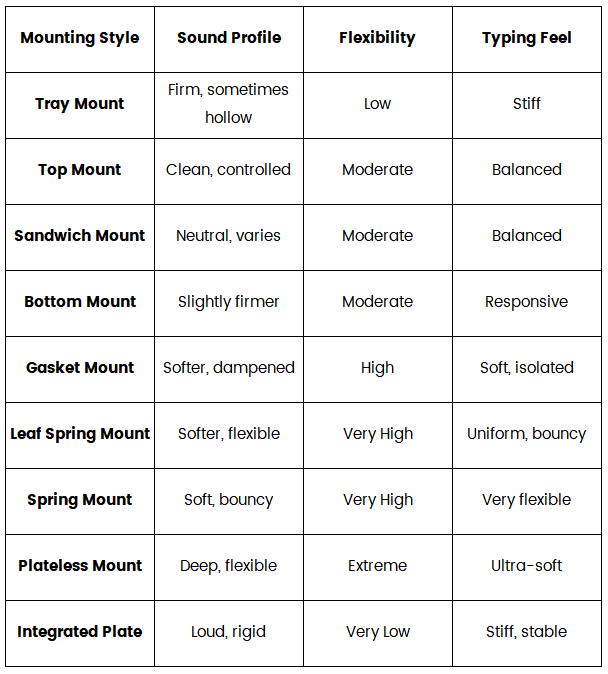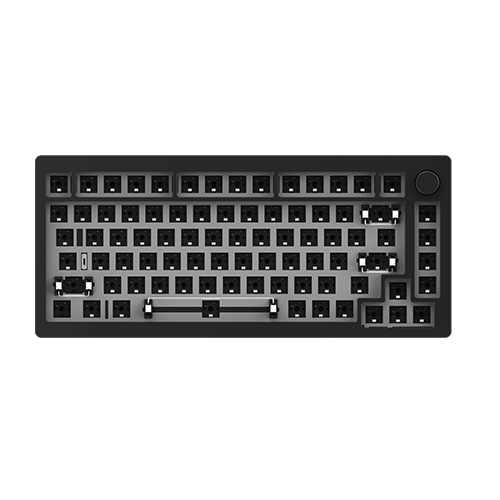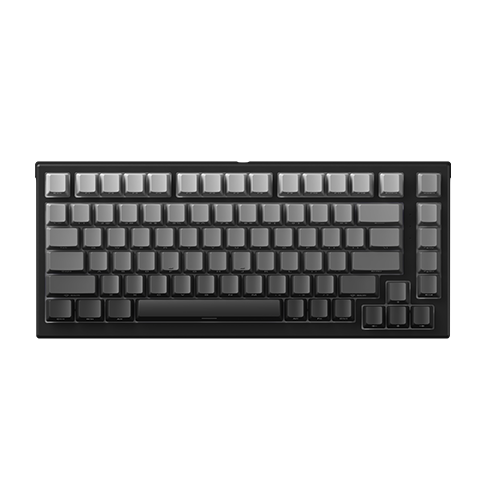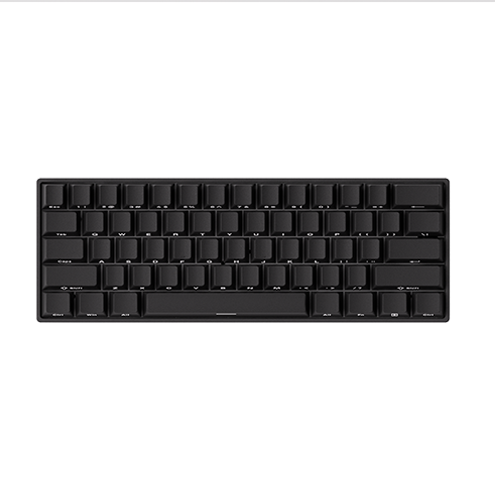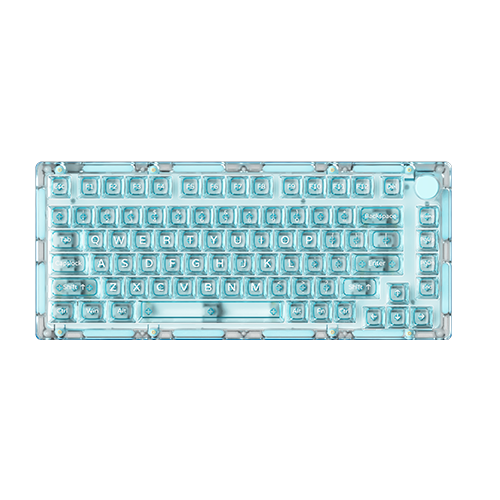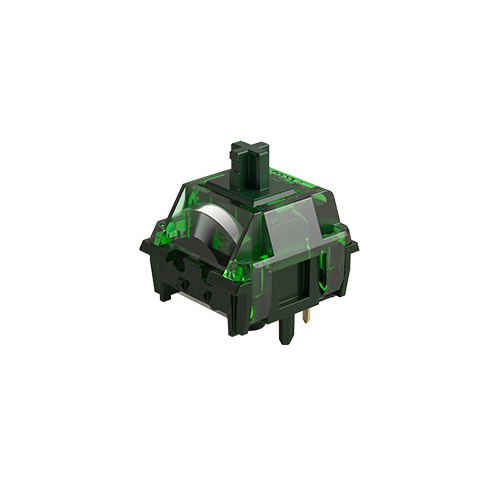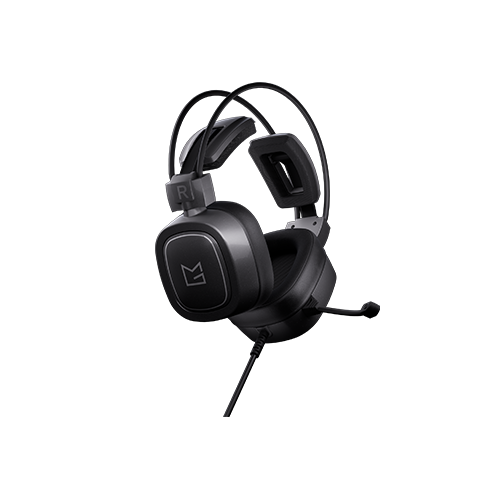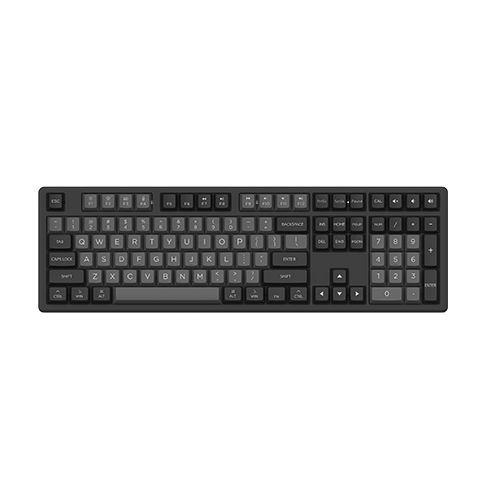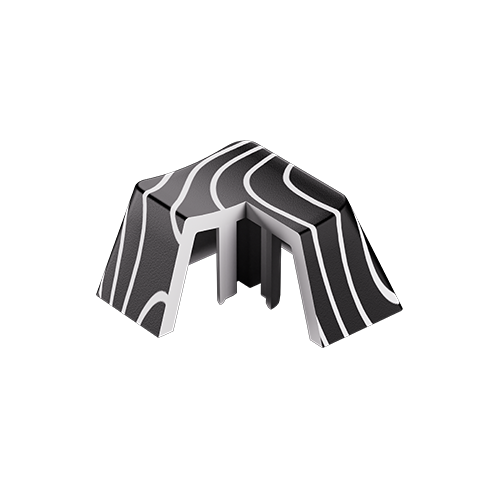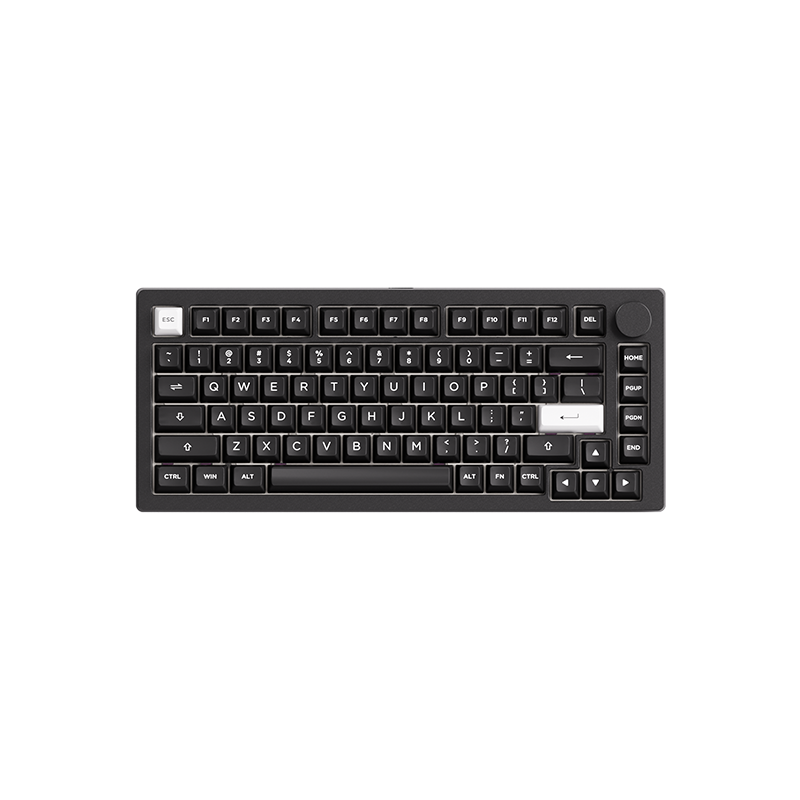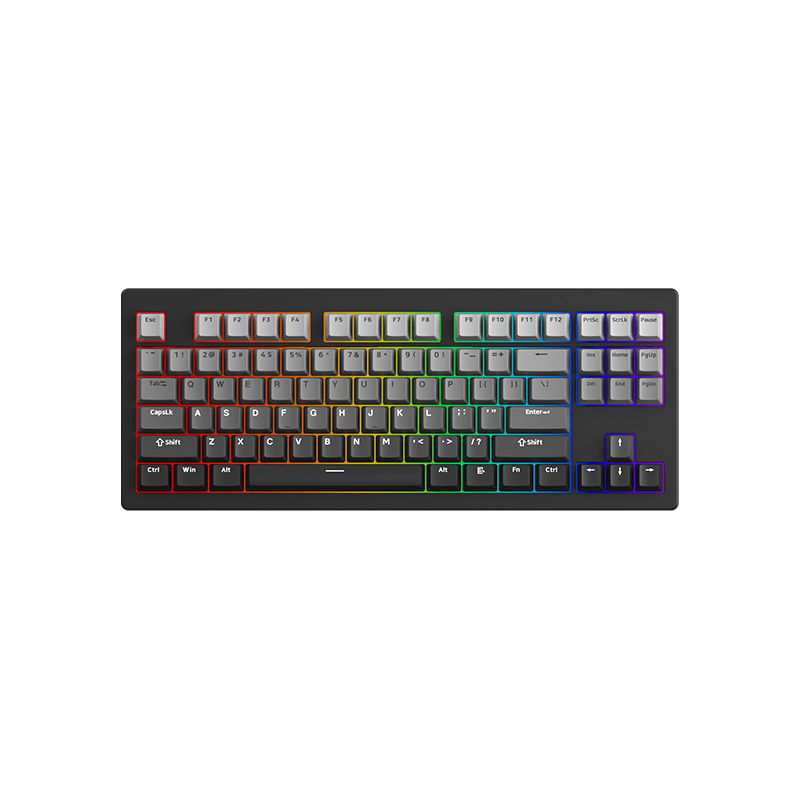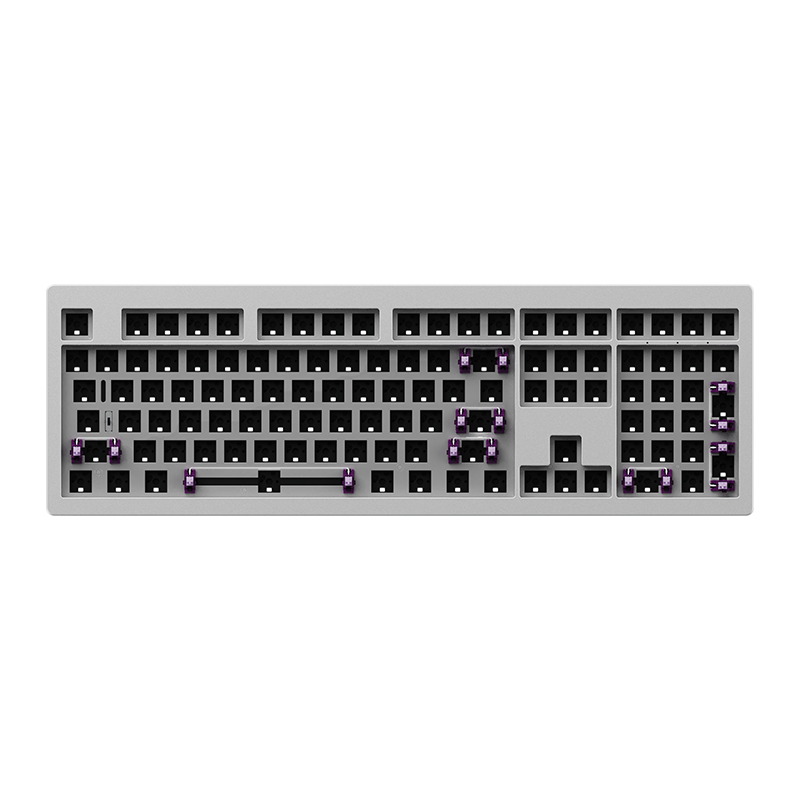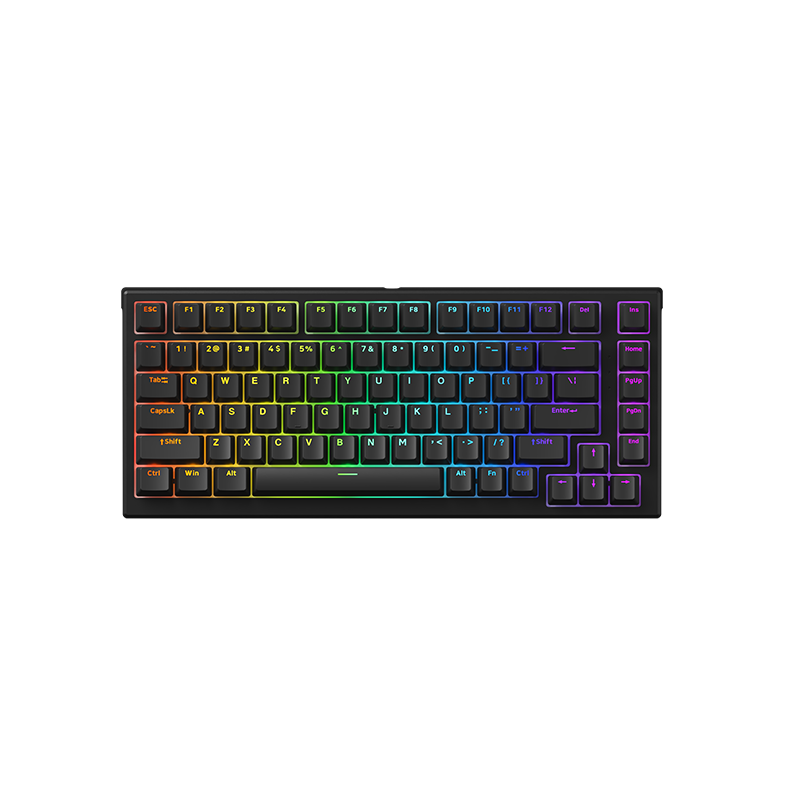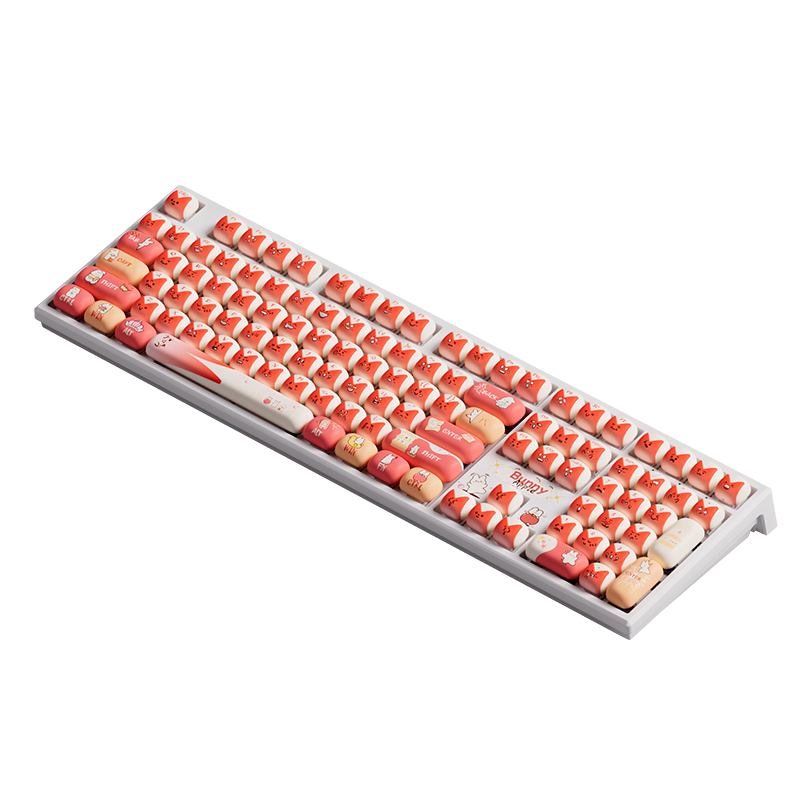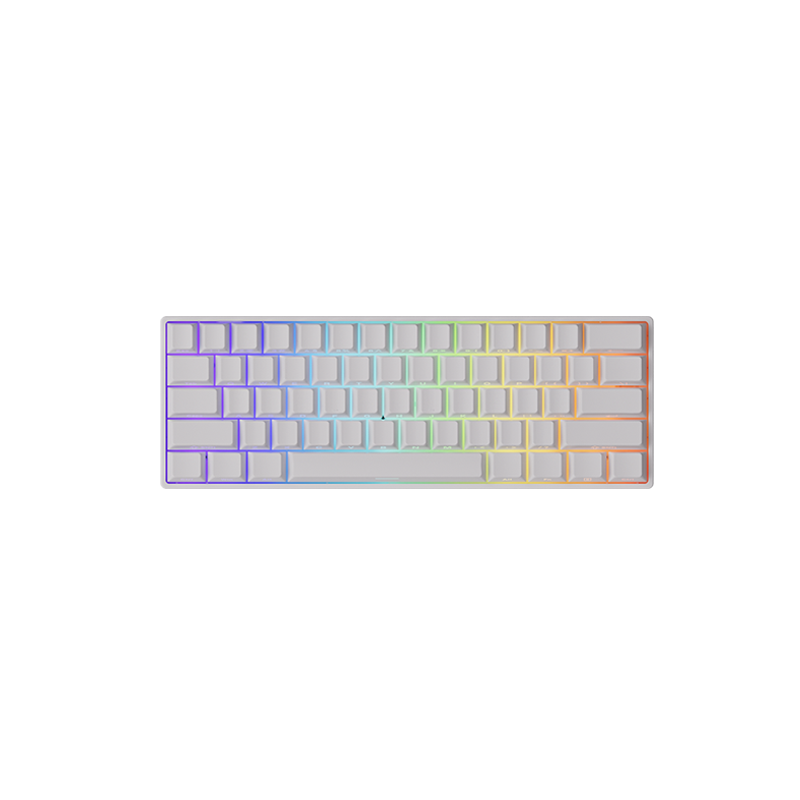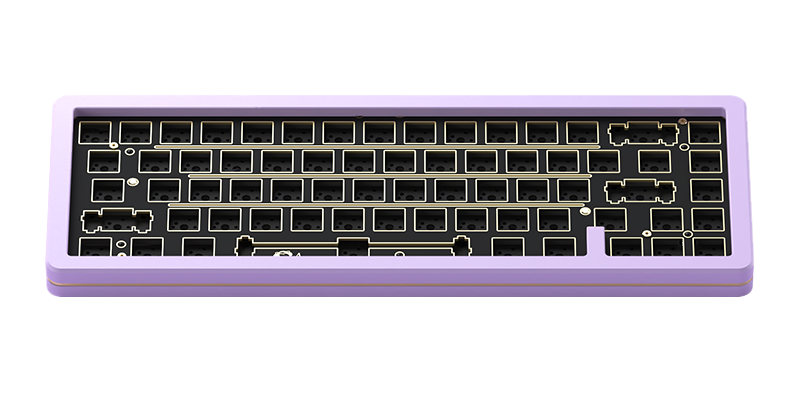Comprehensive Guide to Mechanical Keyboard Mounting Styles

The mounting style refers to how the plate, PCB, and case are connected. Different mounting structures significantly affect the keyboard’s feel, sound, and overall user experience. Below is a detailed analysis of main mounting styles:
1. Gasket Mount
Principle: Uses silicone, rubber, or foam gaskets around the edges of the plate to suspend it inside the case.
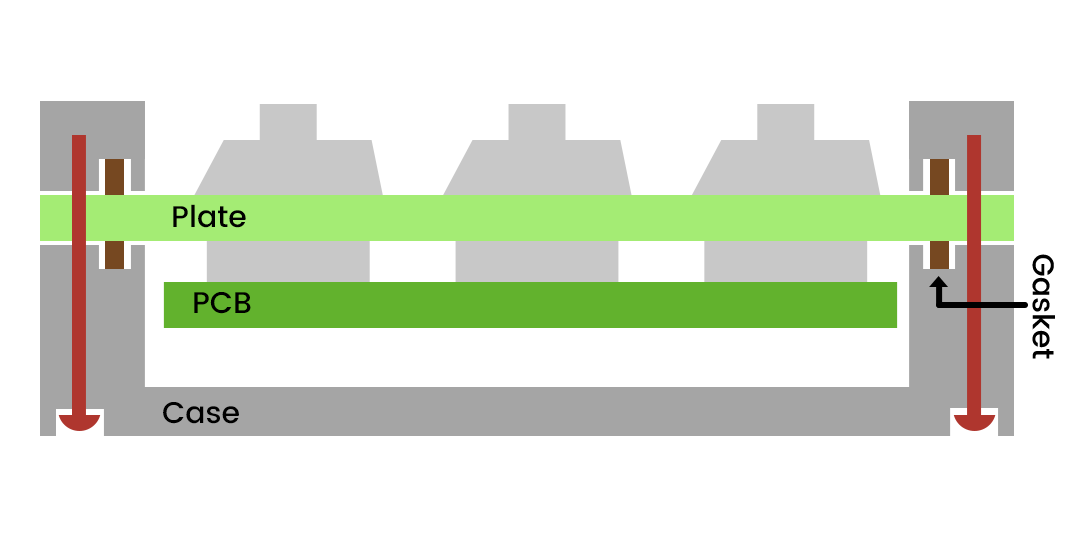
Advantages:
– Provides a soft typing experience
– Reduces harsh bottoming out sensations when typing
– Lowers overall keyboard noise
– Offers slight bounce back and flexibility
Disadvantages:
– Higher manufacturing costs
– More complex design and assembly
– Gaskets may age or compress over time
Typing Experience: Gasket Mount provides a unique “floating” feeling with slight depression and rebound during typing, similar to typing on a soft surface. This structure effectively absorbs typing impact, reducing finger fatigue. The overall feel is uniform, soft with good bounce – a premium experience sought by many keyboard enthusiasts.
Sound Characteristics: Gasket mounted keyboards typically produce deeper, rounder sounds as impacts are absorbed by the gaskets, minimizing sharp noises. The sound profile is often described as “thocky” (deep and substantial) rather than “clacky” (crisp and loud), with consistent sound regardless of whether edge or center keys are pressed.
2. Top Mount
Principle: The plate is directly secured to the case from the top using screws.
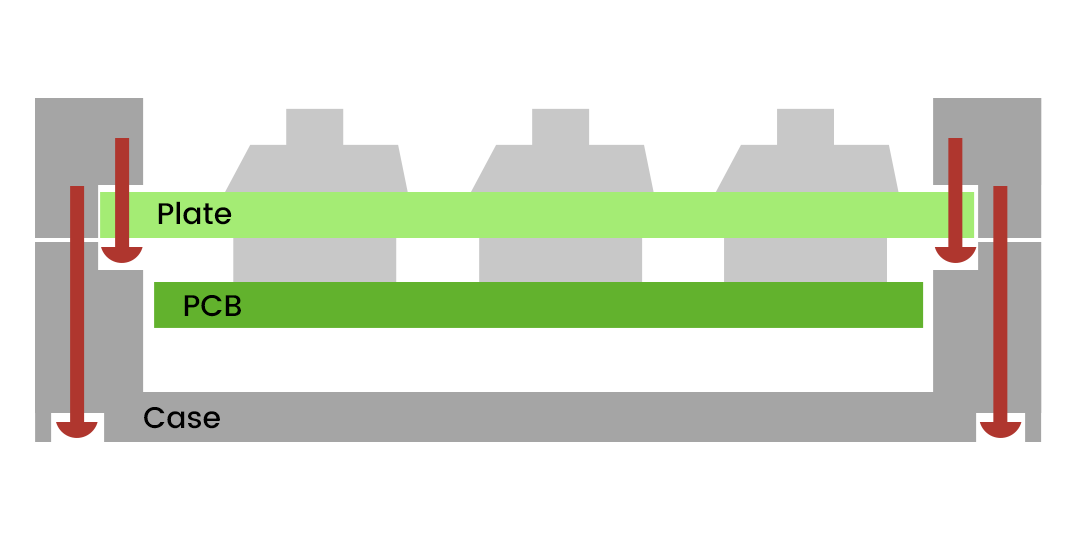
Advantages:
– Generally simpler and more cost-effective manufacturing
– Sturdy and rigid typing feel
– Offers direct feedback from key presses
– Easier to disassemble and modify
– Often compatible with a wider range of cases
– Consistent typing feel regardless of key position
Disadvantages:
– A stiffer typing experience compared to gasket mounts (however, people may like it….)
– May result in louder typing sounds
– More prone to vibration and resonance
Typing Experience: Top Mount provides a firm and stable typing experience with minimal flex. The direct connection between the plate and the case results in a more immediate and solid feel, emphasizing the impact of each keystroke. This rigidity can be beneficial for users who prefer a more precise and responsive typing experience, although it may be less comfortable for extended typing sessions.
Sound Characteristics: Top mounted keyboards tend to produce a sharper and more pronounced sound profile due to the direct transfer of vibrations to the case. The sound is often described as “clacky” or “crisp,” depending on the materials used and the overall case design. While it may lack the depth of a gasket mount, a well-designed top mount can still produce a satisfying and distinct sound.
3. Bottom Mount
Principle: The plate is secured to the case from the bottom using screws, opposite to Top Mount.
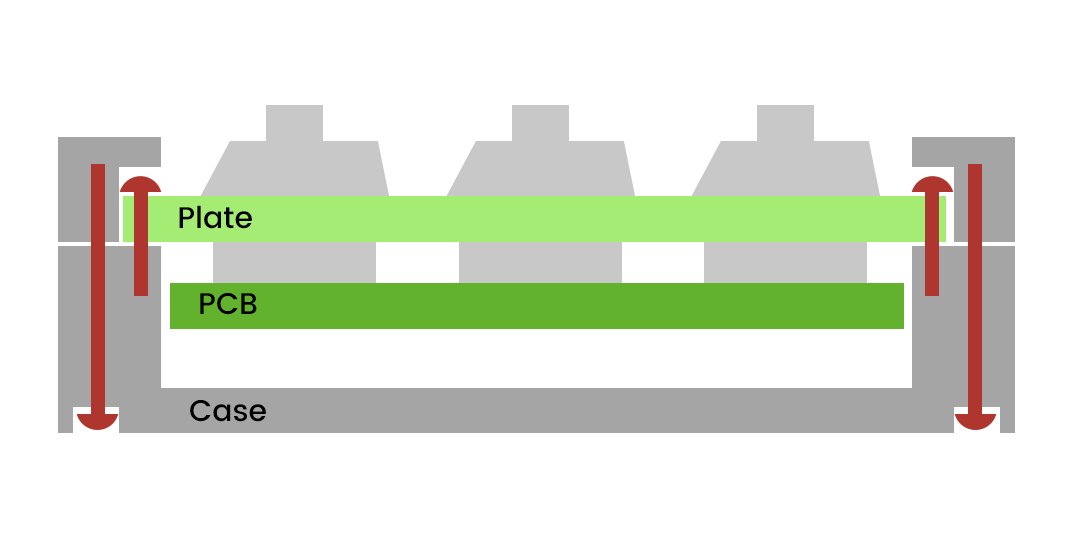
Advantages:
– Provides a softer typing experience than Top Mount
– Has a certain degree of flexibility and bounce
– Typing sound is usually more rounded than Top Mount
– Clean appearance with no visible screws on top
– Relatively uniform typing feel across keyboard areas
Disadvantages:
– Assembly and maintenance more complex than Top Mount
– Requires complete disassembly to adjust or replace the plate
– Less flexibility than Gasket mounting
– Design and manufacturing costs slightly higher than Top Mount
Typing Experience: Bottom Mount provides a firm and stable typing experience with minimal flex. The direct connection between the plate and the case results in a more immediate and solid feel, emphasizing the impact of each keystroke. This rigidity can be beneficial for users who prefer a more precise and responsive typing experience, although it may be less comfortable for extended typing sessions.
Sound Characteristics: Bottom mounted keyboards tend to produce a sharper and more pronounced sound profile due to the direct transfer of vibrations to the case. The sound is often described as “clacky” or “crisp,” depending on the materials used and the overall case design. While it may lack the depth of a gasket mount, a well-designed bottom mount can still produce a satisfying and distinct sound.
4. Tray Mount
Principle: The PCB is directly secured to the case tray from the bottom using screws.
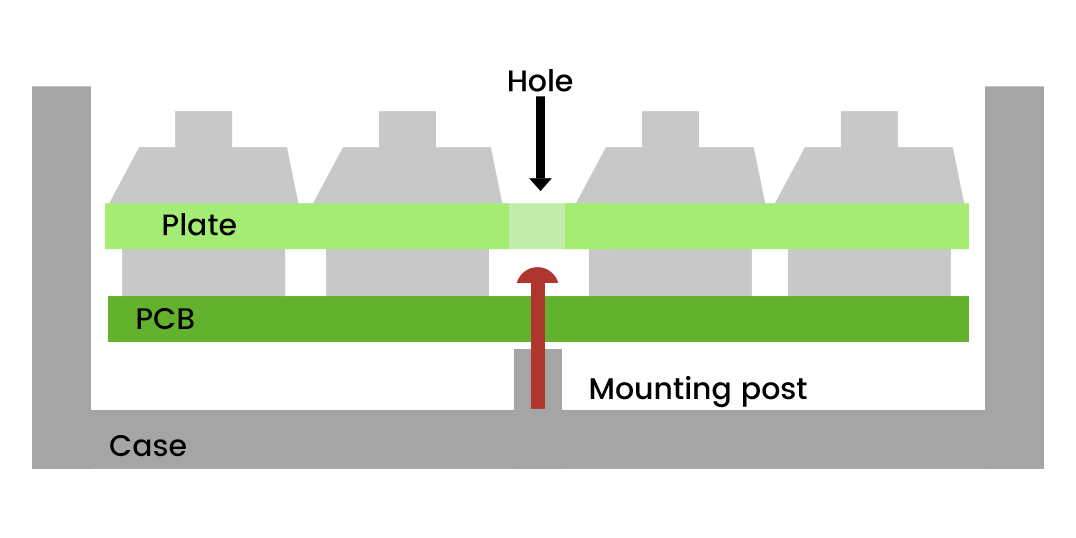
Advantages:
– Simplest and most economical mounting method
– Easy to disassemble and assemble
– Suitable for entry-level DIY keyboards
Disadvantages:
– Most uneven typing experience
– Keys near screw positions feel harder
– May produce louder typing noise
– Almost no flexibility or bounce back
Typing Experience: Tray Mount delivers a relatively firm and inconsistent typing experience. Since the PCB attaches directly to the case, keys near screws feel noticeably harder than keys in other areas. This creates an inconsistent typing feel across the keyboard. There’s minimal overall flexibility or bounce, resulting in a direct, rigid typing experience suitable for users with budget constraints or those preferring a firm feel.
Sound Characteristics: Tray mounted keyboards typically produce louder, inconsistent sounds. Keys near screw positions sound tighter and sharper, while areas away from screws may sound more open and resonant. Lacking dampening structures, these keyboards often produce metallic resonance or “ping” sounds, especially during forceful typing. The overall sound profile is more “clacky” with prominent high frequencies.
5. Sandwich Mount
Principle: The plate is sandwiched between the upper and lower case, secured together with screws.
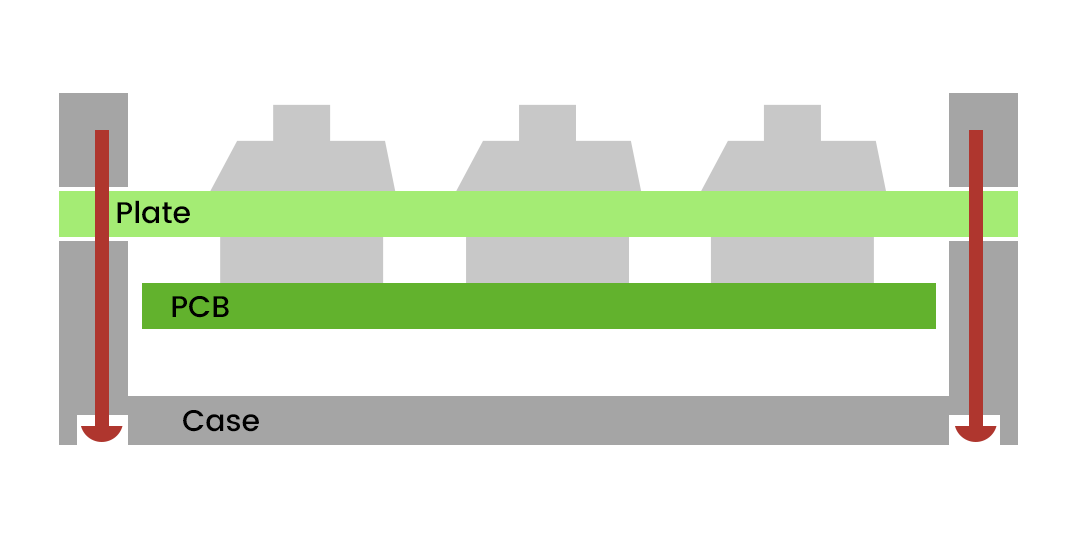
Advantages:
– More uniform typing experience than Tray Mount
– Medium level of flexibility
– Simple structure but more refined than tray mounting
– Relatively stable typing feel
Disadvantages:
– Relatively complex disassembly
– May require frequent disassembly of the entire case for adjustments
– Less flexibility than Gasket mounting
Typing Experience: The sandwich mount design offers a balanced typing experience by placing the plate between layers of the case, without direct contact with screws or gaskets. This results in a firm yet slightly cushioned feel, providing a stable keystroke with moderate flex. It strikes a balance between rigidity and softness, delivering a consistent and responsive typing experience.
Sound Characteristics: Sandwich-mounted keyboards typically produce balanced sounds with both substantial bass and clear high frequencies. Sound remains fairly consistent across the keyboard, though slight metallic resonance may occur. The overall sound profile falls between “thocky” and “clacky,” with tone largely depending on plate material.
6. Integrated Plate
Principle: The plate is integrated with the top of the case, typically using CNC machining.
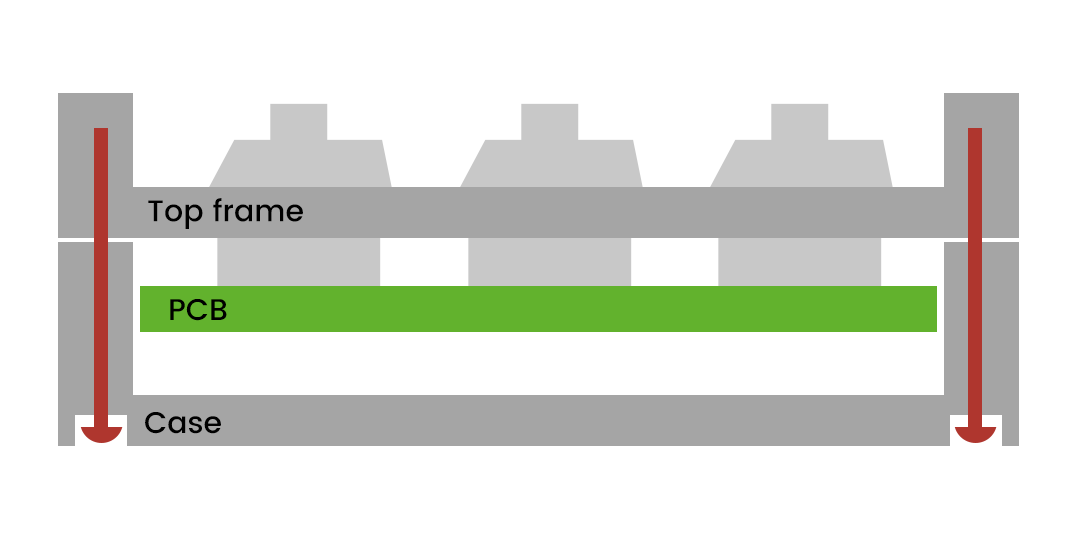
Advantages:
– Extremely high structural integrity and durability
– No additional installation parts required
– Extremely stable typing experience
– Precise feel
Disadvantages:
– Very high manufacturing cost
– Non-replaceable plate
– Firmest typing experience, almost no flexibility
– Sound feedback may be louder
Typing Experience: Integrated Plate provides the firmest, most stable typing experience. With plate and case formed as a single unit, there’s virtually no flexibility or rebound. Each keystroke delivers an extremely solid, direct feeling ideal for users seeking maximum precision and stability. Typing produces almost no depression, with tactile feedback coming solely from the switches. Feel remains highly consistent across the entire keyboard.
Sound Characteristics: Integrated Plate keyboards typically produce very clear, loud sounds with minimal dampening. The sound profile tends toward “clacky” with very pronounced high frequencies. The extremely rigid structure may produce noticeable metallic resonance, especially with metal materials. While overall sound characteristics depend heavily on materials used, this mounting style typically produces the loudest, crispest sounds of all mounting methods.
7. Plateless Mount
Principle: Completely removes the traditional keyboard plate, with switches mounted directly on the PCB.
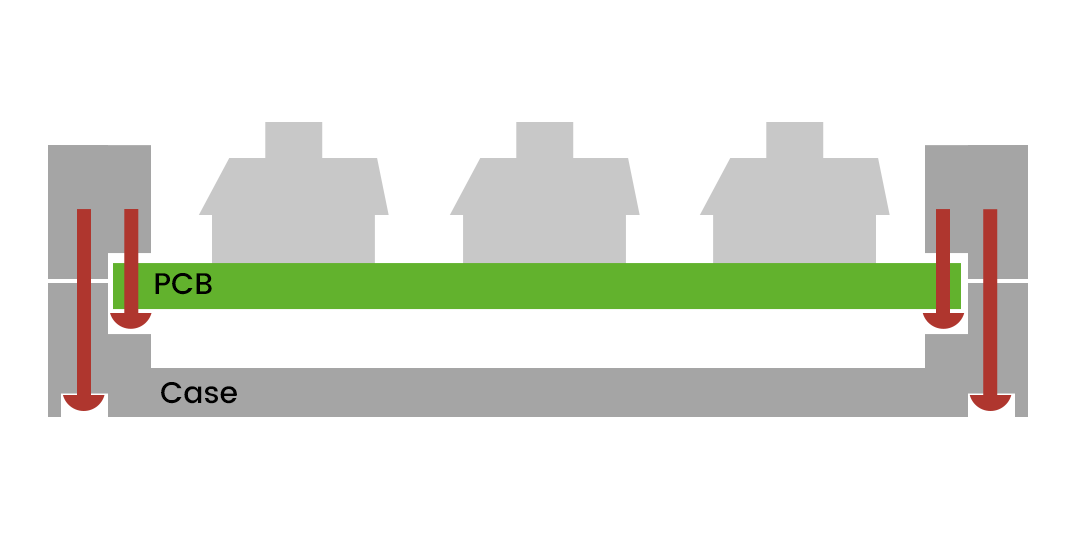
Advantages:
– Provides one of the softest typing experiences
– Each key has an independent flex feeling
– Unique sound characteristics, typically deeper and more rounded
– Reduces overall keyboard weight
– Potentially lower cost (saves on plate material)
Disadvantages:
– Poorer structural stability
– Switch mounting is less secure than with a plate
– Not suitable for all types of switches (especially those requiring additional support)
– Assembly process is more complex and time-consuming
– Stabilizer installation can be challenging
Typing Experience: Plateless mounting provides a very soft and flexible typing experience. Each key has a noticeable independent feel, and the lack of plate constraints makes the keypress sensation more free and flexible. This structure is particularly suitable for users seeking to maximize keyboard softness.
Sound Characteristics: With the plate removed, the sound is typically deeper, more rounded, and lacks the high-pitched sounds that come with metal plates. Often described as more “thocky” with stronger resonance.
8. Spring Mount
Principle: Uses metal springs between the plate and bottom case for mounting, creating a floating effect with elasticity.
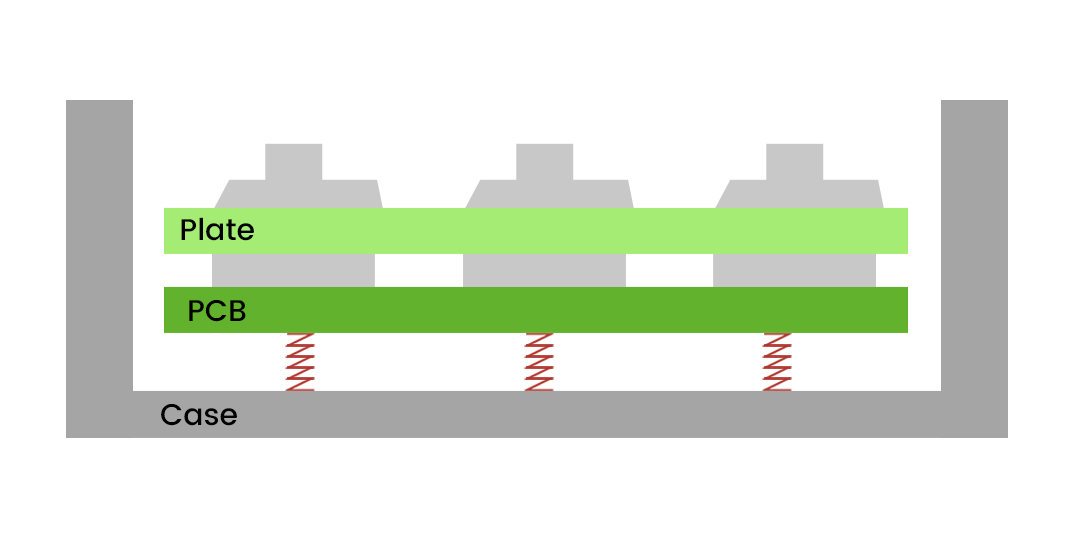
Advantages:
– Provides a unique “springy” bounce back feeling
– Highly adjustable flexibility (by replacing springs of different hardness)
– Excellent sound resonance characteristics
– Reduces typing fatigue
– Can achieve a very uniform typing experience
Disadvantages:
– Very complex design and manufacturing
– Expensive
– May require periodic maintenance and adjustment
– May produce a unique “spring sound”
– Complex installation process requiring precise adjustment
Typing Experience: Spring Mount provides a unique elastic experience with noticeable bounce back on each keypress. This structure creates a “floating” sensation, making the keyboard feel as if it’s gently bouncing while typing. Offers more dynamic flexibility than Gasket Mount.
Sound Characteristics: The spring structure typically produces rich low-pitched sounds, sometimes accompanied by slight “spring noise.” Overall sound characteristics are often deep and layered.
9. Leaf Spring Mount
Principle: Uses thin metal leaf springs as support structures for the keyboard PCB or plate, forming a special suspended mounting method.
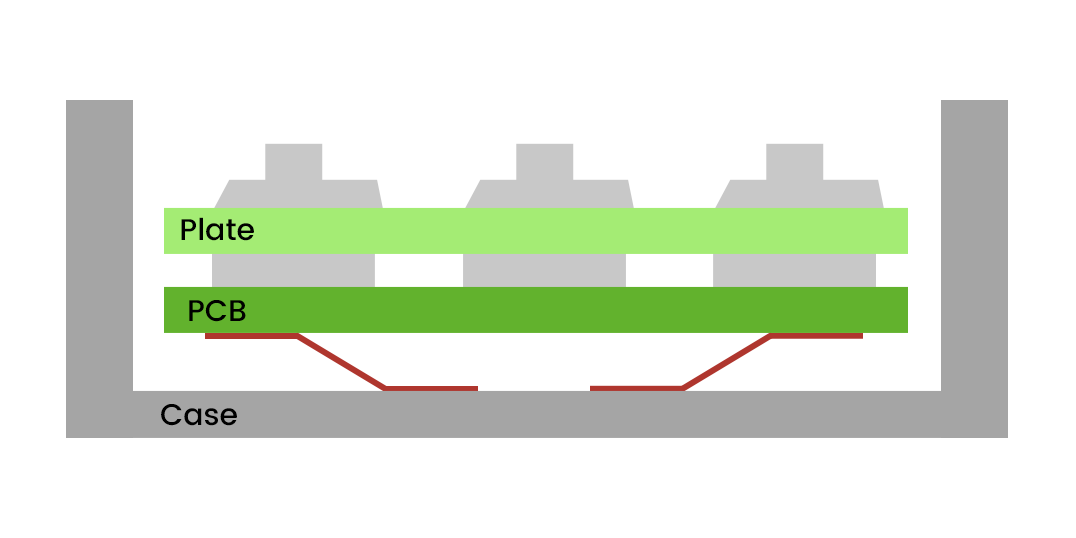
Advantages:
– Provides precisely controlled flexibility
– More compact design than traditional springs
– Elegant sound characteristics
– Lasting elasticity (unlike rubber gaskets that age over time)
Disadvantages:
– Extremely complex design and manufacturing
– Very high cost
– Adjustment and maintenance require specialized knowledge
– May be more sensitive to specific typing postures
– Limited choices in the market
Typing Experience: Leaf Spring Mount typically provides a precise and well-controlled elastic experience. Compared to Spring Mount, its flexibility is more refined and restrained, yet still very noticeable. This structure creates a high-quality “medium-soft” feel that is both flexible and controlled.
Sound Characteristics: Leaf spring structures typically produce clear but not harsh sounds with good resonance characteristics. The sound is often described as “clean,” “crisp,” yet with a certain depth and warmth.
Comparison of Mounting Styles
Softness/Flexibility Comparison: Plateless Mount > Spring Mount and Leaf Spring Mount > Gasket Mount > Bottom Mount > Sandwich Mount > Top Mount and Tray Mount > Integrated Plate
Typing Uniformity Comparison for Reference: Leaf Spring Mount > Gasket Mount > Integrated Plate and Spring Mount > Bottom Mount > Top Mount > Plateless Mount > Sandwich Mount > Tray Mount
Cost and Complexity Comparison: Spring Mount and Leaf Spring Mount > Gasket Mount > Integrated Plate > Bottom Mount > Sandwich Mount > Top Mount > Tray Mount > Plateless Mount
*Note: These orders are just for reference. Due to different designs and materials, results may vary.
Recommended Uses
-
Tray Mount: Best for entry-level DIY, easy to assemble.
-
Top Mount: Ideal for custom keyboards, offering firm yet cushioned feel.
-
Sandwich Mount: Suitable for balanced DIY builds, often in acrylic or aluminum cases.
-
Bottom Mount: Good for mid-to-high-end keyboards, balancing cost and feel.
-
Gasket Mount: Perfect for high-end customs, providing a soft, isolated feel.
-
Leaf Spring Mount: Great for flexible premium builds with uniform typing.
-
Spring Mount: Recommended for high-end experimental designs, offering bounce.
-
Plateless Mount: Ideal for ultra-flexible typing, deep keystrokes.
-
Integrated Plate: Common in budget/prebuilt keyboards, stable but stiff.
Quick Reference Chart
